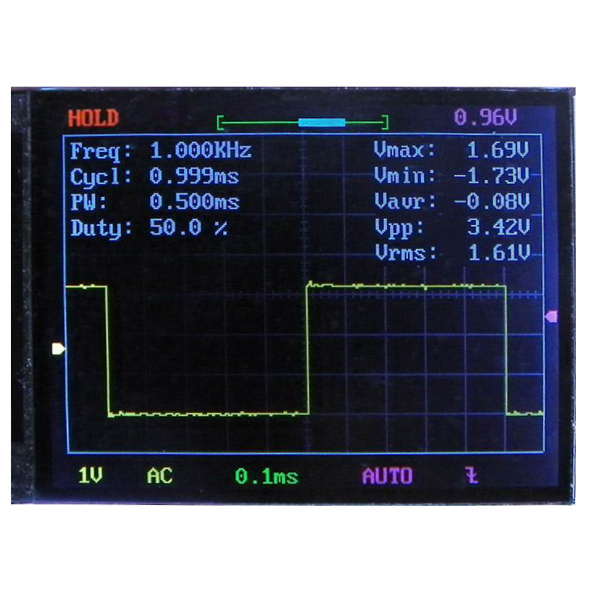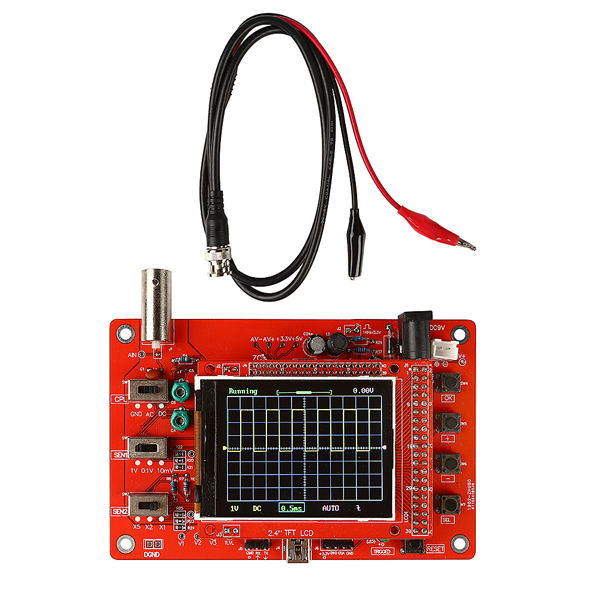موجودی انبار : 2 عدد
4 از 5.0 با 32 رای
کیت اسیلوسکوپ دیجیتال DSO138 دارای نمایشگر رنگی
کاربرد اسیلوسکوپ DSO138:
- تعمیرات
- آزمایشگاه
- کارگاه ها
مشخصات اسیلوسکوپ DSO138:
- میکروکنترلر: (ARM Cortex-M3(STM32F103C8
- تعداد کانال: 1
- پهنای باند آنالوگ: 200 ~ 0 کیلوهرتز
- حساسیت: 10mV/Div ~ 5V/Div
- حساسیت خطا: کمتر از 5 درصد
- رزولوشن: 12 بیت
- حداکثر ولتاژ ورودی: 50 ولت
- کوپلینگ: DC، AC و GND
- حداکثر نرخ نمونه برداری زمان واقعی: 1 مگا نمونه بر ثانیه
- زمان پایه: 10us/Div - 500s/Div
- طول رکورد: 1024
- حالت های راه اندازی: اتوماتیک، خودکار، تک حالته
- مدل های راه اندازی: لبه بالارونده یا لبه پایین رونده
- موقعیت راه اندازی: نصف اندازه بافر تنظیم شده
- نمایشگر: LCD از نوع TFT، با رزولوشن 240 × 320
- منبع تغذیه: 9 ولت DC (قابل قبول در رنج 12 ~ 8 ولت)
- جریان منبع: 120 میلی آمپر
- ابعاد: 15 × 76 × 117 میلی متر
مستندات:
دیتاشیت اسیلوسکوپ
نحوه استفاده از کیت DSO138
Description:
A digital oscilloscope is a complex electronic device composed of
various software and electronic hardware modules that work together to
capture, process, display and store data that represents the signals of
interest of an operator.
DSO138 was designed as a beginner kit. It contains only the basic
oscilloscope functions with no fancy features. Simplicity in structure
and easiness in assembly/operation are amongst the main highlights of
the design. For these purposes, DSO138 uses mostly through-hole parts.
The main processor of DSO138 is a Cortex-M3 ARM (STM32F103C8) from ST.
It uses a 2.4-inch TFT LCD (320 X 240 dot matrix, 262K colors) that
displays waveforms.
By contrast, a digital oscilloscope first samples the waveform and
converts it into a digitally coded signal by an analog-to-digital
converter. The oscilloscope processes this digital signal to reconstruct
the waveform on the screen. Storage in a digital format enables data
processing even by connected PC's.
Features:
MCU: ARM Cortex-M3 (STM32F103C8 )
Number of Channel: 1
Analog Bandwidth: 0 - 200KHz
Sensitivity: 10mV/Div - 5V/Div
Sensitivity Error: < 5%
Resolution: 12-bit
Maximum Input Voltage: 50Vpk
Coupling: DC, AC, GND
Max Real-time Sampling Rate: 1Msps
Time-base: 10us/Div - 500s/Div
Record Length: 1024
Trigger Modes: Auto, Normal, Single
Trigger Types: Rising/falling edge
Trigger Position: 1/2 of buffer size fixed
Display: 2.4-inch color TFT LCD with 320 x 240 resolution
Supply Voltage : 9V DC (8-12V acceptable)
Supply Current: 120mA
Dimension: 117mm X 76mm X 15mm






